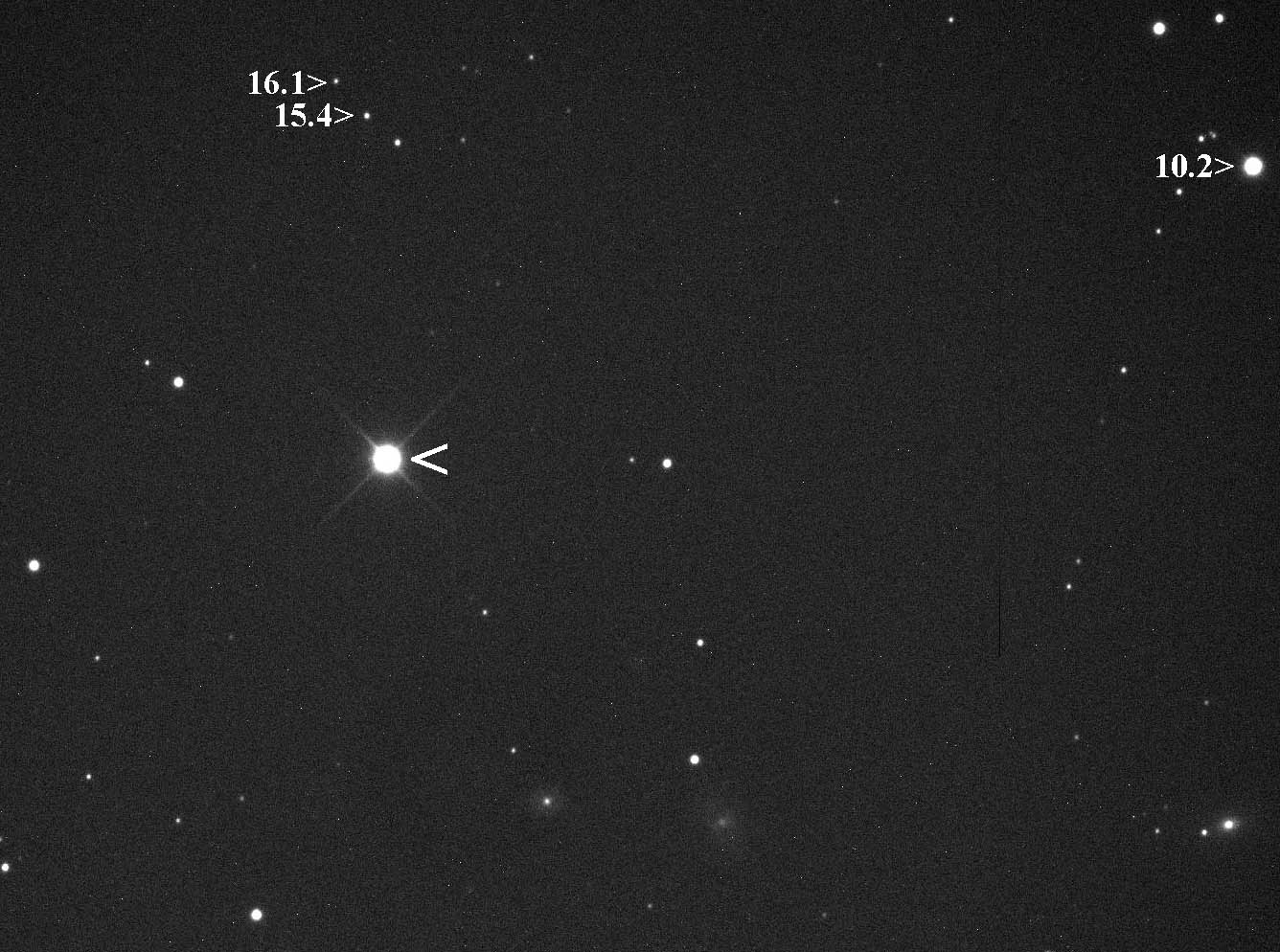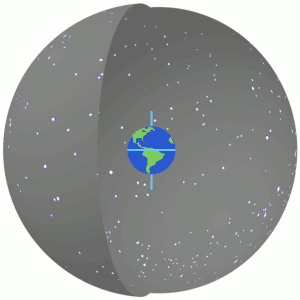|
Lick Object Of 1921
The Lick Object of 1921 is an unidentified astronomical object that was observed from the Lick Observatory in August 1921. Although follow-up observations were not successfully conducted, it is hypothesized that this object is highly likely a non-periodic comet. Observational history William Wallace Campbell reported the sighting of a star-like object about three degrees from the Sun on the evening of 7 August 1921. Observers noted that the object was as bright as Venus, reaching an apparent magnitude of –2 at its maximum. A possibility that it was a nova explosion was ruled out due to its high relative position (about 40 degrees) to the Galactic plane. Zdenek Sekanina and Rainer Kracht published a study in 2016 where they concluded that the Lick object is highly likely a fragment of the same parent body as the comet C/1847 C1 (Hind). Their findings suggested that the Lick Object and C/1847 C1 splitted from a parent body sometime during their perihelion on the 7th millennium ... [...More Info...] [...Related Items...] OR: [Wikipedia] [Google] [Baidu] |
William Wallace Campbell
William Wallace Campbell (April 11, 1862 – June 14, 1938) was an American astronomer, and director of Lick Observatory from 1901 to 1930. He specialized in spectroscopy. He was the tenth president of the University of California from 1923 to 1930. Biography He was born on a farm in Hancock County, Ohio, the son of Robert Wilson and Harriet Welsh Campbell. After a few years of local schooling he entered in 1882 the University of Michigan to study civil engineering, graduating Bachelor of Science in 1886. Whilst at university he developed his interest in astronomy when he read Simon Newcomb's ''Popular Astronomy''. After graduating he was appointed Professor of Mathematics at the University of Colorado but soon moved back to Michigan as an instructor in astronomy. In 1891 he was invited to work on spectroscopy at Lick Observatory in California. Campbell was a pioneer of astronomical spectroscopy and catalogued the radial velocities of stars. He was also recognized for his work i ... [...More Info...] [...Related Items...] OR: [Wikipedia] [Google] [Baidu] |
Lick Observatory
The Lick Observatory is an astronomical observatory owned and operated by the University of California. It is on the summit of Mount Hamilton (California), Mount Hamilton, in the Diablo Range just east of San Jose, California, United States. The observatory is managed by the University of California Observatories, with headquarters on the University of California, Santa Cruz campus, where its scientific staff moved in the mid-1960s. It is named after James Lick. The first new moon of Jupiter to be identified since the time of Galileo, Amalthea (moon), Amalthea, the planet's fifth moon, was discovered at this observatory in 1892. Early history Lick Observatory is the world's first permanently occupied mountain-top observatory. The observatory, in a Classical Revival architecture, Classical Revival style structure, was constructed between 1876 and 1887, from a bequest from James Lick of $700,000, . Lick, originally a carpenter and piano maker, had arrived from Peru in San Franc ... [...More Info...] [...Related Items...] OR: [Wikipedia] [Google] [Baidu] |
Comet
A comet is an icy, small Solar System body that warms and begins to release gases when passing close to the Sun, a process called outgassing. This produces an extended, gravitationally unbound atmosphere or Coma (cometary), coma surrounding the nucleus, and sometimes a Comet tail, tail of gas and dust gas blown out from the coma. These phenomena are due to the effects of solar radiation and the outstreaming solar wind plasma acting upon the nucleus of the comet. Comet nuclei range from a few hundred meters to tens of kilometers across and are composed of loose collections of ice, dust, and small rocky particles. The coma may be up to 15 times Earth's diameter, while the tail may stretch beyond one astronomical unit. If sufficiently close and bright, a comet may be seen from Earth without the aid of a telescope and can Subtended angle, subtend an arc of up to 30° (60 Moons) across the sky. Comets have been observed and recorded since ancient times by many cultures and religion ... [...More Info...] [...Related Items...] OR: [Wikipedia] [Google] [Baidu] |
Venus
Venus is the second planet from the Sun. It is often called Earth's "twin" or "sister" planet for having almost the same size and mass, and the closest orbit to Earth's. While both are rocky planets, Venus has an atmosphere much thicker and denser than Earth and any other rocky body in the Solar System. Its atmosphere is composed of mostly carbon dioxide (), with a global sulfuric acid cloud cover and no liquid water. At the mean surface level the atmosphere reaches a temperature of and a pressure 92 times greater than Earth's at sea level, turning the lowest layer of the atmosphere into a supercritical fluid. Venus is the third brightest object in Earth's sky, after the Moon and the Sun, and, like Mercury, appears always relatively close to the Sun, either as a "morning star" or an "evening star", resulting from orbiting closer ( inferior) to the Sun than Earth. The orbits of Venus and Earth make the two planets approach each other in synodic periods of 1.6 years ... [...More Info...] [...Related Items...] OR: [Wikipedia] [Google] [Baidu] |
Nova
A nova ( novae or novas) is a transient astronomical event that causes the sudden appearance of a bright, apparently "new" star (hence the name "nova", Latin for "new") that slowly fades over weeks or months. All observed novae involve white dwarfs in close binary systems, but causes of the dramatic appearance of a nova vary, depending on the circumstances of the two progenitor stars. The main sub-classes of novae are classical novae, recurrent novae (RNe), and dwarf novae. They are all considered to be cataclysmic variable stars. Classical nova eruptions are the most common type. This type is usually created in a close binary star system consisting of a white dwarf and either a main sequence, subgiant, or red giant star. If the orbital period of the system is a few days or less, the white dwarf is close enough to its companion star to draw accreted matter onto its surface, creating a dense but shallow atmosphere. This atmosphere, mostly consisting of hydrogen, is heated by ... [...More Info...] [...Related Items...] OR: [Wikipedia] [Google] [Baidu] |
Right Ascension
Right ascension (abbreviated RA; symbol ) is the angular distance of a particular point measured eastward along the celestial equator from the Sun at the equinox (celestial coordinates), March equinox to the (hour circle of the) point in question above the Earth. When paired with declination, these celestial coordinate system, astronomical coordinates specify the location of a point on the celestial sphere in the equatorial coordinate system. An old term, ''right ascension'' (), "''Ascensio recta'' Solis, stellæ, aut alterius cujusdam signi, est gradus æquatorus cum quo simul exoritur in sphæra recta"; roughly translated, "''Right ascension'' of the Sun, stars, or any other sign, is the degree of the equator that rises together in a right sphere" refers to the ''ascension'', or the point on the celestial equator that rises with any celestial object as seen from Earth's equator, where the celestial equator perpendicular, intersects the horizon at a right angle. It contrasts wi ... [...More Info...] [...Related Items...] OR: [Wikipedia] [Google] [Baidu] |
Declination
In astronomy, declination (abbreviated dec; symbol ''δ'') is one of the two angles that locate a point on the celestial sphere in the equatorial coordinate system, the other being hour angle. The declination angle is measured north (positive) or south (negative) of the celestial equator, along the hour circle passing through the point in question. The root of the word ''declination'' (Latin, ''declinatio'') means "a bending away" or "a bending down". It comes from the same root as the words ''incline'' ("bend forward") and ''recline'' ("bend backward"). In some 18th and 19th century astronomical texts, declination is given as ''North Pole Distance'' (N.P.D.), which is equivalent to 90 – (declination). For instance an object marked as declination −5 would have an N.P.D. of 95, and a declination of −90 (the south celestial pole) would have an N.P.D. of 180. Explanation Declination in astronomy is comparable to geographic latitude, projected onto the celestial sphere, and ... [...More Info...] [...Related Items...] OR: [Wikipedia] [Google] [Baidu] |
Zdenek Sekanina
Zdeněk Sekanina (born 12 June 1936) is a Czech-American astronomer and scientist. In 1959, Sekanina studied astronomy at Charles University in Prague, where he graduated in 1963. After the Soviet invasion of Czechoslovakia in 1968, he emigrated to the United States. Since 1980, he has been working at the Jet Propulsion Laboratory. His main areas of professional study are meteors and interplanetary dust as well as the study of comets. During the course of his investigations, he dealt with Halley's comet, the Tunguska event, as well as the break-up and impact of Comet Shoemaker–Levy 9 on Jupiter. He was involved in the data evaluation of the Giotto, Stardust, and Solar and Heliospheric Observatory The Solar and Heliospheric Observatory (SOHO) is a European Space Agency (ESA) spacecraft built by a European industrial consortium led by Matra Marconi Space (now Airbus Defence and Space) that was launched on a Lockheed Martin Atlas IIAS la ... missions. The asteroid 1913 ... [...More Info...] [...Related Items...] OR: [Wikipedia] [Google] [Baidu] |
Rainer Kracht
This is a list of minor-planet discoverers credited by the Minor Planet Center with the discovery of one or several minor planets (such as near-Earth and main-belt asteroids, Jupiter trojans and distant objects). , the discovery of 612,011 numbered minor planets are credited to 1,141 astronomers and 253 observatories, telescopes or surveys ''(see )''. On how a discovery is made, ''see observations of small Solar System bodies. For a description of the tables below, see ''. Discovering astronomers Discovering dedicated institutions Discovering sites Notes The discovery table consist of the following fields: * Astronomers and Institutions: links to the corresponding article about the discovering astronomer or institution on Wikipedia. If not linked, the displayed name should be a redirect to this list. For example, the page forwards to the anchored table row using the astronomer's MPC-name as ID. * Discoveries: displays the total number of discovered and ... [...More Info...] [...Related Items...] OR: [Wikipedia] [Google] [Baidu] |
C/1847 C1 (Hind)
Hind's Comet, formally designated as C/1847 C1, is a non-periodic comet that became visible to the naked eye in March 1847. It is the second comet discovered by English astronomer, John Russell Hind John Russell Hind FRS FRSE LLD (12 May 1823 – 23 December 1895) was an English astronomer. Life and work John Russell Hind was born in 1823 in Nottingham, the son of lace manufacturer John Hind and Elizabeth Russell, and was educated at .... References External links * Non-periodic comets Discoveries by John Russell Hind {{Comet-stub ... [...More Info...] [...Related Items...] OR: [Wikipedia] [Google] [Baidu] |
Lost Comets
A lost comet is one which was not detected during its most recent perihelion passage. This generally happens when data is insufficient to reliably calculate the comet's location or if the solar elongation is unfavorable near perihelion passage. The ''D/'' designation is used for a periodic comet that no longer exists or is deemed to have disappeared. Lost comets can be compared to lost asteroids (lost minor planets), although calculation of comet orbits differs because of nongravitational forces, such as emission of jets of gas from the comet nucleus, nucleus. Some astronomers have specialized in this area, such as Brian G. Marsden, who successfully predicted the 1992 return of the once-lost periodic comet Comet Swift–Tuttle, Swift–Tuttle. Overview Loss There are a number of reasons why a comet might be missed by astronomers during subsequent apparitions. Firstly, cometary orbits may be perturbation (astronomy), perturbed by interaction with the giant planets, such as Jup ... [...More Info...] [...Related Items...] OR: [Wikipedia] [Google] [Baidu] |







